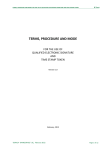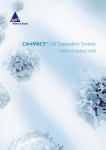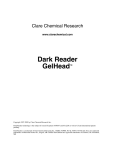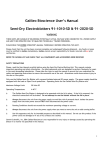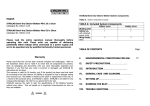Download PRODUCTINSERT SSP Minor Histocompatibility Antigen Primer Sets
Transcript
One Lambda, Inc. 21001 Kittridge Street, Canoga Park, CA 91303-2801 Tel: (818) 702-0042 Fax: (818) 702-6904 WEB:www.onelambda.com P R O D U C T I N S E R T SSP Minor Histocompatibility Antigen Primer Sets Catalog # BSSPMHAG For Research Use Only. Not for use in diagnostic procedures. STORE REAGENTS AT TEMPERATURE INDICATED ON PACKAGE. USE BEFORE EXPIRATION DATE. Warning: Use only the D-mix packaged with this Liquid Bulk Primer Set. DIRECTIONS FOR USE: Formulation Use the following formulation to prepare the reagents for your test: 1. Use 2 µl of primer set per PCR reaction. 2. Use 1 µl of the test sample and 7 µl D-mix per reaction. 3. Use .05 µl at 5 units/µl of recombinant Taq polymerase per reaction. 4. Perform standard PCR with the Micro SSP™ PCR program (OLI-1) as specified below. INTENDED USE DNA typing of the Minor Histocompatibility locus HA-1. SUMMARY AND EXPLANATION Successful marrow stem cell engraftment requires that bone marrow (BM) donor-recipient pairs be matched for HLA-A, -B, -DR, and –DQ. Nevertheless, among HLA genotypeidentical donor recipient pairs, acute graft-versus-host disease (GvHD) occurs in 15%-35% of cases after allogeneic BM transplantation, depending on the age of the recipient and the amount of T-cell depletion of the graft. The occurrence of acute GvHD has been ascribed to mismatching the minor histocompatibility antigens (mHags) encoded by the HA-1 locus.1 The HA-1 locus is composed of two alleles, HA-1H and HA-1R, which differ in two nucleotides, resulting in a single amino acid substitution. Disparities between mHags of otherwise HLA-identical bone marrow donor and recipient pairs can elicit strong major histocompatibility complex restricted cytotoxic and proliferative T-cell responses which can be measured in vitro.2 It has been demonstrated that HLA-A*0201 molecules have a high affinity for the HA-1H peptide, and this mHag peptide/MHC complex is recognized by HA-1 specific cytotoxic T-cells.3 PRINCIPLE The PCR-SSP methodology is based on the principle that completely matched oligonucleotide primers are more efficiently used in amplifying a target sequence than a mismatched oligonucleotide primer by recombinant Taq polymerase. Primer pairs are designed to have perfect matches only with a single allele or group of alleles. Under strictly controlled PCR conditions, perfectly matched primer pairs Rev 2 BSSPMHAG_PI.DOC result in the amplification of target sequences (i.e., a positive result) while mismatched primer pairs do not result in amplification (i.e., a negative result). After the PCR process, the amplified DNA fragments are separated by agarose gel electrophoresis and visualized by staining with ethidium bromide and exposure to ultraviolet light. Interpretation of PCR-SSP results is based on the presence or absence of specific amplified DNA fragment. Since the amplification during the PCR reaction may be adversely affected by various factors (pipetting errors, poor DNA quality, presence of inhibitors, etc.), an internal control primer pair is included in every PCR reaction. The control primer pair amplifies a conserved region of the human β-globin gene, which is present in all DNA samples and is used to verify the integrity of the PCR reaction. In the presence of a positive typing band (specific amplification of an HA-1 allele), the product of the internal control primer pair may be weak or absent due to the differences in concentration and melting temperatures between the specific primer pairs and the internal control primer pair. The amplified DNA fragments of the specific HLA primer pairs are smaller than the product of the internal control primer pair, but larger than the diffuse, unincorporated primer band. Thus, a positive reaction for a specific HA-1 allele is visualized on the gel as an amplified DNA fragment between the internal control product band and the unincorporated primer band (see Results Section). Page 1 of 4 REAGENTS A. Identification The SSP Minor Histocompatibility Antigen Primer Sets provide sequence-specific oligonucleotide primers for amplification of alleles and the human β-globin gene by the polymerase chain reaction (PCR) and specially formulated dNTP buffer mix (Primer Set D-mix). The internal control PCR product amplified from the human β-globin gene is the most likely contaminating PCR product due to its amplification in every test reaction. The amount of each primer is adjusted for optimal amplification of 100 ng of sample DNA when used in conjunction with the Primer Set D-mix, the prescribed amount of recombinant Taq polymerase, and the PCR reaction profile detailed below. B. Warning or Caution 1. For research use only. Not for use in diagnostic procedures. 2. Limit refreezing of primers no more than twice. 3. Pipettes used for Post-PCR manipulations should not be used for Pre-PCR manipulations. 4. Biohazard Warning: The ethidium bromide used for staining of DNA is a potential carcinogen. Always wear gloves when handling stained gels. 5. Biohazard Warning: All blood products should be treated as potentially infectious. 6. Caution: Wear UV-blocking eye protection, and do not view UV light source directly when viewing or photographing gels. 7. Aliquot D-mix into convenient to use volumes. Do not refreeze more than twice. C. Storage Instructions Store reagents at temperature indicated on package. Use before printed expiration date. D. Purification for Treatment Required for Use See “Directions for Use” below. E. Instability Indications 1. Any primer set with a vial that is damaged should be considered unusable. 2. If salts have precipitated out of the solution in the D-mix aliquots during shipping or storage, re-dissolve by extended vortexing at room temperature (20-25°C). 3. D-mix aliquots, upon thawing at room temperature (20 25°C), should be pink to light purple in color. Any D-mix aliquot without the specified coloration should be considered unusable. Rev 2 BSSPMHAG_PI.DOC INSTRUMENT REQUIREMENTS 1. Programming the Thermocycler The following program is designed for use only on the PerkinElmer 9600 or 9700 thermocyclers. If you have a different make and/or model thermocycler, you may need to adapt the programming to your machine. Program your thermocycler before starting the “Directions for Use.” Micro SSP™ PCR Program (OLI-1): # of Cycles Step Temp (°C) Time (sec) 1 1 2 96 63 130 60 9 1 2 96 63 10 60 20 1 2 3 96 59 72 10 50 30 End 1 4 --- For specific thermocycler information, refer to the manufacturer’s user manual. 2. 2.5% Agarose Gel Preparation (for Micro SSP™ Gel System, OLI Cat. #MGS108) a. To set up: • Slide the locking pin on the base to the open position. • Insert the gel box into the base by sliding the locking pin into the locked position. • Use the leveling bubble and the three height adjustable legs to level the base. b. Orient and fully insert the 14 gel combs into the gel comb holder. c. To 100 ml of 1x Tris Borate EDTA buffer (1xTBE) with 0.5 µg/ml ethidium bromide (in a 500 ml glass bottle), add 2.5 g electrophoresis grade agarose. Heat until a homogeneous solution is formed. d. Add 30 ml of the gel solution to the gel box. Make sure the agarose covers the entire surface evenly by tilting the gel box back and forth immediately after the gel solution is added. Quickly place the gel comb holder on the filled gel box by matching the color coding. Allow to set for 15 minutes. e. Remove the gel combs by lifting the gel comb holder while holding the base. Add 10 ml of 1X TBE containing 0.5 µg/ml ethidium bromide evenly across the gel to fill every well. Page 2 of 4 3. Gel Electrophoresis (for Micro SSP™ Gel System, OLI Cat. #MGS108) a. Transfer each PCR reaction (10 µl) in sequence to the 2.5% agarose gel. Make sure to transfer all samples in the proper sequence. (No addition of electrophoresis dye is necessary.) Use of an 8- or 12-channel Pipetman® is recommended. b. Cover the gel box with the gel box cover by matching the color-coded sides. Electrophorese the samples at 140 - 150 volts until the red tracking dye has migrated about 0.5 cm into the gel (approximately 3 -5 minutes, depending on the agarose used). Remove the cover. c. Slide the locking pin on the base to the open position and remove the gel box. Transfer the gel box to a UV transilluminator. Photograph the completed gel. SPECIMEN COLLECTION AND PREPARATION 1. DNA can be purified from human leukocytes by any preferred method. 2. The DNA sample to be used for PCR-SSP analysis should be re-suspended in sterile water or in 10 mM Tris-HCl, pH 8.0 - 9.0 at a concentration of 25 - 200 ng/µl with the A260/A280 ratio of 1.65 - 1.80. 3. Samples should not be re-suspended in solutions containing chelating agents, such as EDTA, above 0.5 mM in concentration. 4. DNA samples may be used immediately after isolation or stored at -20° C or below for extended periods of time (over 1 year) with no adverse effects on results. 5. DNA samples should be shipped at 4° C or below to preserve their integrity during transport. PROCEDURE A. Materials Provided 1. 2 vials, 60 µl primer (2µl per test) each 2. 1000 µl Primer Set D-mix (7 µl per test) Note: The volumes provided are slightly more than the amount required for testing. This is to account for inadvertent losses which may result from pipetting. B. Materials Required, but Not Provided • Pipetting devices, such as Gilson® P20, Gilson® P200 Pipetman® • Disposable pipette tips • Vortex mixer • Microcentrifuge • PCR tray microtube storage rack and cover (Robbins Scientific, Cat #1044-39-5) • Thermocycler for PCR with 96-well format and tray/retainer for 0.2 ml thin-walled reaction tubes • Hot plate or microwave oven for heating agarose solution • Electrophoresis apparatus/power supply (150V minimum capacity) Rev 2 BSSPMHAG_PI.DOC • • • • UV transilluminator (example: Fotodyne FOTO/UV®21) Photographic or image documentation system 1x TBE buffer (89mM Tris Borate; 2 mM disodium EDTA, pH 8.0) with 0.5 µg/ml ethidium bromide or 5XTBE Buffer with Ethidium bromide (OLI Cat. # 5XTBE100) Electrophoresis grade agarose (e.g., FMC Seakem® LE) C. Step-by-Step Procedures Test Procedure Refer to “Directions for Use”. LIMITATIONS OF THE PROCEDURE PCR-SSP is a dynamic process requiring highly controlled conditions to insure discriminatory amplification. The procedure provided this product must be strictly followed. The extracted sample DNA provides the template for the specific amplification process and, thus, must have its concentration and purity within the ranges specified in the procedure. All instruments (e.g., PCR machine, pipetting devices) must be calibrated according to the manufacturer’s recommendations. RESULTS A. Data Analysis 1. An internal control band (slower-migrating) should always be visible in negative wells (except in the negative control well) as a control for successful amplification. Non-amplification of any well can void test results. 2. A faster-migrating, positive typing band will be observed on the electrophoretic gel if a specific mHag gene was amplified during PCR. This indicates a positive test result. 3. The internal control band may be weak or absent in positive wells. 4. A positive band indicates the presence of the allele identified in the table on the next page (Primer Recognition Sites). B. Gel Interpretation Positive Reaction Negative Reaction Nonamplification Well Internal Control Band Positive Typing Primer Band Page 3 of 4 PRIMER RECOGNITION SITES* Alleles HA-1H (Histidine) 5’ Recognition Site 345ACACT349 3’ Recognition Site 500CTGCA504 Approx. Size Base Pairs 190 HA-1R (Arginine) 345ACACT349 500TTGCG504 190 *Based on the KIAA0223 cDNA Sequence Information, Gene Bank Accession Number D86976. REFERENCES 1. Goulmy E, Schipper R, Pool J, et al. Mismatches of minor histocompatibility antigens between HLA-identical donors and recipients and the development of graft-versus-host disease after bone marrow transplantation. New Engl Med 1996: 334:281-5. 2. Goulmy E., Human minor histocompatibility antigens. Curr Opin Immunol 1996: 8:75-81. 3. Den Haan JMM, Meadows LM, Wang W, et al. The minor histocompatibility antigen HA-1: a diallelic gene with a single amino acid polymorphism. Science 1998: 279:1054-7. TRADEMARKS USED IN THIS DOCUMENT/ PRODUCT ARMS™ Zeneca Limited FMC SeaKem® FMC Corporation Fotodyne FOTO/UVX®21 FOTODYNE Incorporated Gene-Amp® Hoffmann-LaRoche, Inc Gilson® and Pipetman® Rainin Instrument Co., Inc. Rev 2 BSSPMHAG_PI.DOC PATENTS USED IN THIS DOCUMENT Nothing in this publication should be construed as an authorization or an implicit license to practice PCR under any patents held by Hoffmann-LaRoche, Inc. Gene-Amp PCR Process is covered by U.S. Patent Nos. 4,683,202, 4,683,195, 4,800,159 and 4,965,188 owned by F. Hoffmann-La Roche, Inc. The use of PCR for in vitro diagnostic procedures requires a license that can be obtained by contacting: PCR Licensing Manager F. Hoffmann-LaRoche Building 222/350 CH-4500 Basel Switzerland Director of Licensing Roche Molecular Systems 1145 Atlantic Avenue Alameda, CA 94501 USA SSP technology is licensed from Zeneca Limited, through its Zeneca Diagnostics business, Blacklands Way, Abingdon Business Park, Abingdon, Oxfordshire, England OX14 IDY and covered under the following patents held by Zeneca Corporation: European Patent No. 0 332 435 B1, United States Patent No. 5,595,890,entitled “Method of detecting nucleotide sequences,” and Canadian Patent No. 1323592, and corresponding patents and patent applications worldwide. The SSP Minor Histocompatibility Antigen Primer Sets are manufactured and distributed by One Lambda, Inc., 21001 Kittridge Street, Canoga Park, CA 91303, USA. Page 4 of 4





